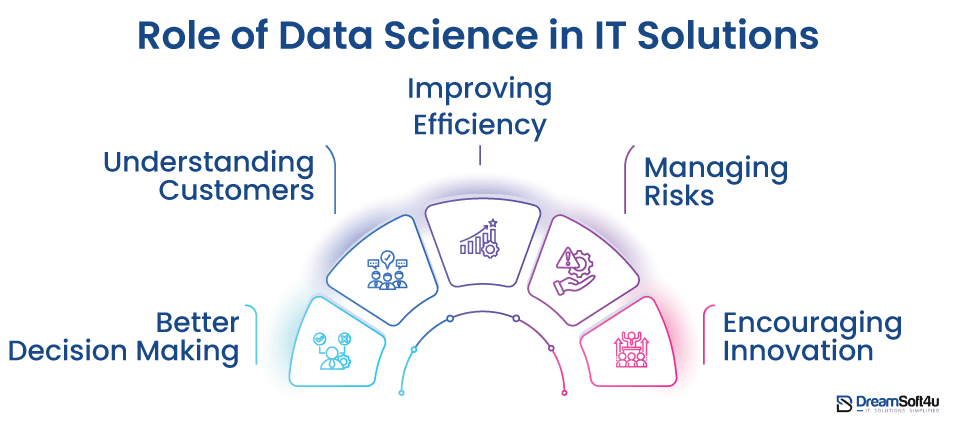What is Data Science and Analytics?
Data science and analytics is a way of using data to find meaningful insights and helpful information. It brings together different skills to study large amounts of data and uncover things businesses didn’t know before. Data is like currency. Companies can use it to improve other areas, such as supply chains, inventory, distribution, customer service, and marketing. The goal is to cut unnecessary costs while increasing profits. Experts in this field are required to use unique methods and tools to answer important questions and solve problems.
Here are some standard methods and tools utilized:
- Data mining
- Data modeling
- Business intelligence
- Predictive analytics
- Machine learning
- Software programming
- Data Engineering
How Does Data Science and Analytics Work?
Data science is not magic. There are specific steps to find valuable insights from the data, which helps businesses make intelligent decisions. Here is how it works:
1. Asking the Right Questions: You need to ask clear and specific questions to get the correct answers. This is where a data scientist helps frame better questions to get valuable answers.
2. Collect the Relevant Data: Once you have the right questions. The next step is gathering the correct data. Sometimes, businesses already have the data they need. But other times, they may need to find new sources.
3. Clean the Data: Not all data is perfect. Before analysis, data scientists remove or fix errors, missing values or incorrect information to ensure accurate results.
4. Analyze the Data: At this stage, the cleaned data is studied. Models are created to find patterns and insights. This process often involves testing different approaches to get the best results.
5. Understand the Results: Once the analysis is done, the data scientist explains the findings using charts, graphs and reports. This helps businesses understand the insights. And use them to make better decisions.
Role of Data Science in IT Solutions

Here are some key areas where data science plays a crucial role:
Better Decision-Making
One of the crucial roles of data science is in decision-making. It helps businesses make informed decisions by analyzing past data and finding patterns for the future. For example, a clothing store can analyze past sales. It helps to see which items are most prevalent during certain seasons. This allows them to stock the right products at the right time, which reduces waste and increases profits.
Understanding Customers
Businesses must know what their customers like and want. Data science helps by collecting and studying customer behaviour, such as shopping habits or preferences. For example, an online store can track what a customer browses. And suggest similar products, making shopping easier and more enjoyable. This personalized approach makes customers feel valued and increases their chances of returning.
Improving Efficiency
Data science helps businesses work more efficiently by identifying problems and fixing them early. For example, in a factory, machines can have sensors that collect data. If the data shows, a machine is about to break down. Maintenance teams can fix it before it stops working completely. This prevents delays, saves money on repairs and keeps production running smoothly.
Managing Risks
Every business faces risks. Whether it is fraud, financial loss or security threats. Data science helps companies identify risks before they become serious problems. For example, banks use data science to detect unusual transactions that might be fraud. Suppose someone tries to use a stolen credit card. The bank can block the transaction immediately. And protecting both the customer and the bank.
Encouraging Innovation
Businesses use data science to find new opportunities and create better products by analyzing customer feedback and market trends. Companies can see what people need but don’t have yet. For example, a mobile phone company might notice that customers want longer battery life. So they work on developing a phone with improved battery performance. This helps them stay ahead of competitors and attract more customers.
Key Components of a Successful Data Science Strategy in IT
Here are some key components of a successful data science strategy:
Collecting and Managing Data Properly
Data is the core part of data science. Businesses gather and store it in an organized and secure way. There are proper systems and processes set up for collecting, storing, and managing data with regulations to ensure the data quality is high and useful for analytics.
Building a Skilled Team
Another essential component is a highly skilled team. Who understand numbers, coding, and the specific industry they are working in. Companies should hire professionals who can analyze data. And use it to improve business decisions. They should also provide training to help their teams stay updated with new trends and technologies.
Using the Right Tools and Technology
It’s time to focus on utilizing the right tools and technologies that are required for data analysis, such as Machine learning software, data visualization programs and AI-based systems. It helps uncover valuable insights. Plus, staying up to date with the latest technology. Which ensures that businesses remain competitive and can make smarter decisions.
Creating a Data-Driven Mindset
Finally, a data-driven mindset is essential for a company. This means training staff to understand and trust data instead of relying only on experience or intuition. When data becomes a part of everyday decision-making, businesses can operate more efficiently and achieve better results.
Visit Original Source:- How Data Science is Transforming IT Solutions Guide

